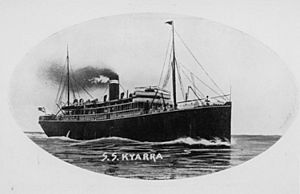Kyarra facts for kids
class="infobox " style="float: right; clear: right; width: 315px; border-spacing: 2px; text-align: left; font-size: 90%;"
| colspan="2" style="text-align: center; font-size: 90%; line-height: 1.5em;" | 
|} The Kyarra was a large, fancy ship built in Scotland in 1903. It weighed about 7,000 tons and was made of steel. The Kyarra was used to carry both goods (cargo) and people (passengers) for the Australian United Steam Navigation Company.
Contents
| History | |
|---|---|
| Name | Kyarra |
| Owner | Australian United Steam Navigation Co. Ltd. |
| Port of registry | Fremantle, Western Australia |
| Builder | William Denny and Brothers, Dumbarton |
| Launched | 2 February 1903 |
| Fate | Sunk by UB-57 on 26 May 1918 |
| General characteristics | |
| Tonnage |
|
| Length | 415 ft 5 in (126.62 m) |
| Beam | 52 ft 2 in (15.90 m) |
| Draught | 31 ft 5 in (9.58 m) |
| Propulsion | 2 × 375 hp (280 kW) triple expansion engines |
| Speed | 15.4 knots (28.5 km/h; 17.7 mph) |
| Capacity |
|
| Armament | 4.7 in (120 mm) gun |
Building the Kyarra
The Kyarra was built by a company called William Denny and Brothers in Dumbarton, Scotland. It was launched into the River Clyde on February 2, 1903. The ship's name, Kyarra, comes from an Aboriginal word. It means a small piece of possum fur.
The Ship's Journeys
For ten years, the Kyarra sailed between Fremantle, Western Australia, and Sydney, New South Wales. It carried both cargo and passengers on these trips. The ship was registered in Fremantle and sailed under the flag of the United Steam Navigation Company.
Kyarra as a Hospital Ship
On November 6, 1914, during World War I, the Kyarra was taken over by the government in Brisbane. It was changed into a hospital ship, known as HMAT A.55 Kyarra. To show it was a hospital ship, its hull was painted white with a large red cross on the side. It carried all the doctors, nurses, and equipment for several Australian hospitals to Egypt.
Kyarra as a Troop Transport
In March 1915, the Kyarra was changed again, this time into a ship for carrying soldiers (a troop transport). The government stopped using the ship on January 4, 1918.
Wireless Communication
In October 1911, the Kyarra's wireless operator, Sidney Jeffryes, became famous for a short time. He set a new record for sending wireless messages over land between ships. The Sydney Sun newspaper reported his achievement.
Jeffryes picked up a signal from another ship, the Cooma, when he was 140 miles (225 km) from Adelaide. This was a new record for overland wireless messages. He later became the wireless operator for the Australian Antarctic Expedition.
The Sinking of the Kyarra
On May 5, 1918, the Kyarra was sailing from Tilbury to Devonport in England. It was going to pick up passengers and more cargo. However, on May 26, 1918, a German submarine called UB-57 sank the Kyarra near Swanage. Six people lost their lives in the sinking.
The Submarine Captain
The captain of UB-57 was Oberleutnant Johannes Lohs. He was 29 years old when he died at sea later that year. UB-57 left Zeebrugge on August 3, 1918. The last time anyone heard from Lohs was on August 14, 1918. It is believed that UB-57 hit a mine near the Straits of Dover. Lohs' body was later found, and he is buried in the Ysselsteyn German war cemetery in the Netherlands.
The Wreck Today
The sunken ship SS Kyarra was found in the late 1960s by a diver. A diving club later bought the wreck. The wreck is about one mile off Anvil Point and is still a popular place for divers to explore.
In honor of the ship, a house built in 1920 in Ipswich, Queensland, was named Kyarra.

